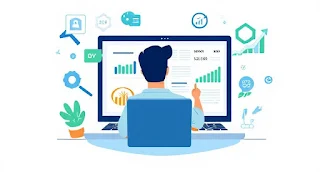Introduction
In today's digital world, creating content is not enough. If your content doesn’t appear in search results, it might as well not exist. That’s where SEO content optimization comes in—a vital practice for anyone who wants their website, blog, or business to thrive online.
SEO content optimization is the process of improving the quality, relevance, and technical structure of your content to make it more attractive to search engines and users. It involves:
- Targeting the right keywords
- Structuring your content for readability
- Enhancing meta tags and headers
- Improving mobile responsiveness and page speed
- Aligning with search intent
🧠 Why Is SEO Content Optimization Important?
Optimizing content isn’t just about traffic. It’s about targeted, qualified traffic—people who are already searching for what you offer.
- Higher search engine rankings = more visibility
- Increased organic traffic = less need for paid ads
- Better user experience = lower bounce rates and more conversions
- Stronger authority = builds trust and credibility
🔍 Step 1: Start With Keyword Research
Keyword research is the backbone of SEO. Without it, you risk creating content no one is searching for.
🎯 What Makes a Good Keyword?
- Relevance to your topic and audience
- Search volume
- Low to medium competition
- Clear search intent
🛠️ Tools to Use:
- Google Keyword Planner
- Ubersuggest
- Ahrefs
- SEMrush
- AnswerThePublic
Tip: Focus on long-tail keywords like “best SEO content optimization tools for beginners.”
🏗️ Step 2: Optimize On-Page SEO Elements
- Title Tag – under 60 characters, include the primary keyword
- Meta Description – under 160 characters, include keyword and a CTA
- Header Tags – use H2s and H3s to organize content
- URL Structure – short and keyword-rich
- Image Optimization – alt text, file names, and compression
🧾 Step 3: Structure Your Content for Readability
- Use short paragraphs (2–4 lines)
- Include bullet points and subheadings
- Incorporate visuals (charts, images, videos)
- Ensure mobile responsiveness
💡 Step 4: Align With Search Intent
Google ranks content based on how well it matches the user's intent.
🎯 Types of Search Intent:
- Informational – "What is SEO content optimization?"
- Navigational – "Ahrefs login page"
- Transactional – "Buy SEO tools online"
- Commercial Investigation – "Best SEO tools for small business"
Action Tip: Google your keyword and analyze the top 10 results. Match the format and depth of those pages.
⚙️ Step 5: Add Technical SEO Enhancements
- Site Speed – use PageSpeed Insights or GTmetrix
- Mobile Friendliness – test with Google’s tool
- Internal Linking – connect related pages
- Schema Markup – improve SERP appearance
🔁 Step 6: Refresh and Repurpose Content
🔄 How to Refresh Content:
- Update statistics and links
- Improve formatting and readability
- Add new sections
🔀 Repurpose Ideas:
- Turn blog posts into videos
- Create infographics or slides
- Use quotes/snippets on social media
🛠️ Step 7: Use Content Optimization Tools
🧰 AI-Powered Tools:
- Surfer SEO
- Clearscope
- Frase
- MarketMuse
✍️ Writing Tools:
- Grammarly
- Hemingway Editor
🔍 SEO Plugins:
- Yoast SEO
- Rank Math
⚠️ Common Content Optimization Mistakes
- Keyword stuffing
- Ignoring search intent
- Over-optimization
- Not tracking performance
📊 How to Measure SEO Content Performance
🧪 Key Metrics:
- Organic traffic
- Time on page
- Bounce rate
- CTR (Click-through Rate)
- Conversion rate
🛠️ Tools to Use:
- Google Analytics
- Google Search Console
- Ahrefs / SEMrush
🧭 Future Trends in SEO Content Optimization (2025 and Beyond)
- AI-Generated Content – Human oversight is still key
- Voice Search Optimization – Use natural language
- Video SEO – Optimize video metadata
- E-E-A-T – Show expertise and trust
✅ Final Thoughts: Start Optimizing Like a Pro
SEO content optimization is both an art and a science. It requires strategy, creativity, and continuous improvement. Done right, it drives rankings, traffic, and engagement.
📌 Quick Recap:
- Start with smart keyword research
- Optimize on-page elements
- Write for readability and intent
- Use tools and data
- Avoid common mistakes
Start implementing today, and watch your content rank higher tomorrow!
Need help creating a checklist, video, or SEO content brief? Let us know!






0 Comments